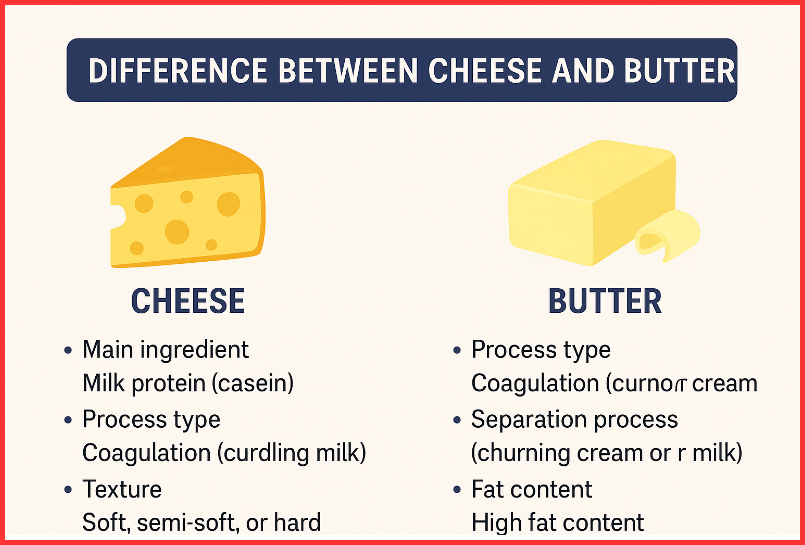Cheese and butter are two of the most popular dairy products used around the world. Both originate from milk, but they differ in composition, preparation, flavor, texture, and culinary uses. The main distinction lies in their key components — cheese is primarily made from milk protein, while butter is mostly composed of milk fat. Understanding the difference between cheese and butter helps in making healthier dietary choices and using them correctly in cooking and baking.
What is Cheese?
Cheese is a dairy product made by curdling milk through a process called coagulation. This is typically achieved by adding rennet, an enzyme that separates milk solids (curds) from liquid (whey). The curds are then processed, pressed, and aged to form cheese.
Cheese can be produced from various types of milk, such as cow, goat, sheep, buffalo, and even camel milk. However, cow’s milk remains the most common because it is widely available and cost-effective.
The flavor and texture of cheese depend on factors like the type of milk, aging duration, bacterial cultures, and additional ingredients. Cheese can range from soft and creamy (like Brie and Mozzarella) to hard and crumbly (like Cheddar or Parmesan).
Cheese is used in countless dishes — from sauces and pizzas to sandwiches and salads. Some cheeses even improve in taste and texture with age, developing complex flavors over time.
What is Butter?
Butter, on the other hand, is a fat-rich dairy product made by churning milk or cream until the fat separates from the liquid (known as buttermilk). This makes butter a separation process, unlike cheese, which is a coagulation process.
Butter consists mainly of milk fat, with small amounts of water and milk proteins. Depending on the preparation method, butter can be salted, unsalted, cultured, or clarified (ghee). Some versions also include flavors like garlic or herbs for culinary variety.
Butter is known for its smooth texture and rich taste, making it a staple in baking, frying, and spreading. It adds flavor, moisture, and tenderness to food — from pastries and pancakes to sautéed vegetables and sauces.
Difference Between Cheese and Butter
| Aspect | Cheese | Butter |
| Main Ingredient | Milk protein (casein) | Milk fat |
| Process Type | Coagulation (curdling milk) | Separation (churning cream or milk) |
| Key Enzyme/Method | Uses rennet or acid to curdle milk | Churning separates fat from liquid |
| Texture | Soft, semi-soft, or hard | Smooth and creamy |
| Fat Content | Moderate | High |
| Calories | Lower compared to butter | Higher calorie content |
| Nutrients | Rich in protein, calcium, and vitamins | High in fat-soluble vitamins (A, D, E, K) |
| Common Uses | Sauces, pizzas, toppings, sandwiches | Baking, frying, spreading |
| Shelf Life | Longer; can be aged | Shorter; best stored refrigerated |
| Health Benefits | Supports bone and teeth health; good calcium source | Provides energy and healthy fatty acids |

Nutritional and Culinary Value- Cheese vs Butter
Both cheese and butter contain essential nutrients, but their nutritional profiles differ.
- Cheese is a good source of calcium, protein, and phosphorus, which help maintain strong bones and teeth. It also contains vitamins A and B12.
- Butter, being rich in saturated fats and calories, provides quick energy and contains fat-soluble vitamins, but it should be consumed in moderation.
From a culinary perspective, cheese enhances flavor and texture, while butter adds richness and smoothness to dishes.
When comparing cheese and butter, their nutritional compositions reveal why they serve different dietary purposes.
Cheese is packed with protein, calcium, and essential minerals, making it a powerhouse for bone and dental health. Its high calcium content helps reduce the risk of osteoporosis and supports strong teeth and bones. A 100-gram serving of cheese contains around 700 milligrams of calcium, along with smaller amounts of sodium, zinc, potassium, and iron.
On the other hand, butter is richer in fats and calories, providing a quick source of energy. It contains valuable minerals like calcium, phosphorus, potassium, and trace amounts of zinc, sodium, and magnesium. Although butter has less protein, it delivers fat-soluble vitamins (A, D, E, and K) that are vital for maintaining healthy skin, vision, and immune function.
In terms of skincare benefits, butter is known to help exfoliate and soften the skin, while cheese contains nutrients that nourish and revitalize it.
Overall, cheese has fewer kilocalories per 100 grams than butter, making it a healthier choice for those watching their calorie or fat intake.
Which is Healthier — Cheese or Butter?
When it comes to health, cheese generally offers more nutritional benefits. It contains less fat and more protein and minerals compared to butter. Dietitians often recommend cheese in balanced quantities for its bone-strengthening properties.
Butter, although flavorful, is high in saturated fat and calories. However, moderate consumption — especially of natural or grass-fed butter — can be part of a healthy diet, as it provides beneficial fatty acids.
Summary: Cheese vs Butter
- Both cheese and butter come from milk but differ in their composition and preparation.
- Cheese is mainly milk protein formed by coagulation, while butter is milk fat produced by churning.
- Cheese offers more protein, minerals, and variety, whereas butter provides rich flavor and fat for cooking and baking.
- In terms of health, cheese is the better option due to its lower fat and higher nutrient content.
Final Thoughts
In short, the difference between cheese and butter lies in their base components and processing methods. Cheese is rich in protein and calcium, making it a healthy food choice, while butter is primarily fat that enhances the flavor of foods. Both have their place in a balanced diet when enjoyed in moderation.
Read Next: